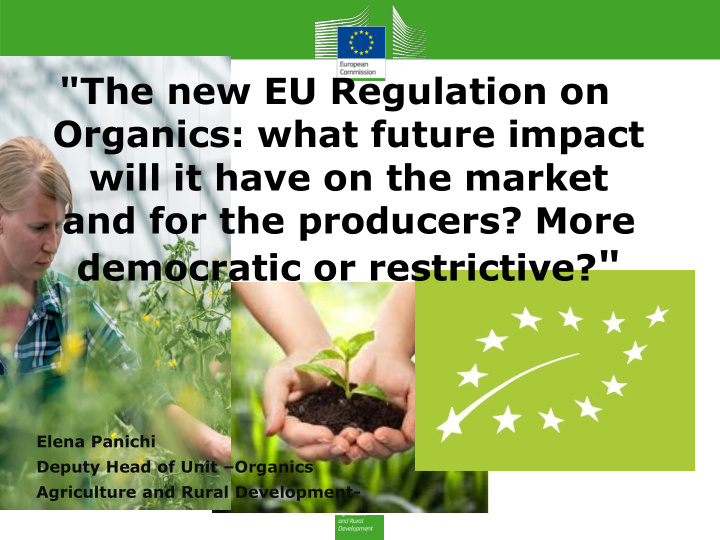



"The new EU Regulation on Organics: what future impact will it have on the market and for the producers? More democratic or restrictive? " Elena Panichi Deputy Head of Unit – Organics Agriculture and Rural Development-
EUROPE: ORGANIC EVOLUTION 2007-2016 +63% 6,7% In 2016, almost 0.85 Increasing relevance in in the million hectares more terms of UAA in the last of EU were reported decade decade to reach almost compared with 2015. farmland is 7% of the total Utilised 2007-2016 Agricultural Area organic Organic surface in MIO of Ha 14 Percentage of the UAA 12 8 10 6 8 6 4 4 2 2 0 0 2007 2008 2009 2010 2011 2012 2013 2014 2015 2016 Nine countries have 10% or more of their European Union agricultural land under organic management. 11.9 Million ha (2016)
EUROPE: ORGANIC RETAIL SALES 2016 Germany European 9.5 bio € Union 30.7 bio € The European Union (30.7 billion € ) is the The European countries with second largest single market after the US the largest markets for (38.9 billion) and followed by China. organic food are Germany (9.5 billion € ), France (6.7 billion € ), Italy (2.6 billion € ), and the UK (2.5 billion € ). Distribution of retail sales value worldwide by country 2016 0 5.000 10.000 15 years ago organic market Retail sales in million Euros value: around 5 bio € Source: FiBL survey 2018 www.organic- world.net
THE ORGANIC REFORM: A LONG STORY 2014 2015 2017 2018 2021 Com. EU Council Vote in the Date of Political proposal General Approach Council and EP entry into compromise and + application endorsement Amendments Publication in voted in EP the OJ plenary
THE ORGANIC REFORM: A LONG STORY Why a new regulation? • Certain provisions are 20 years old, did not forsee the incredible development of the organic sector. • Many gray areas; growing number of requests for the legal interpretations of certain provisions. • Too many derogations granted on a case-by-case basis; too many discrepencies on the application of the rules between Member States. • Increasing risk of formal complaints being introduced by some operators against unfair competition. • Current regulation not in line with the Lisbon treaty.
THE ORGANIC REFORM: A LONG STORY Why the reform took so long? • Wide varieties of views and positions between the three European Institutions, Member States and within the sector. • Several issues on which it was difficult to find an acceptable compromise for all parties: pesticides, controls, cultivation in greenhouses using demarcated beds. • Final outcome: balanced compromise between fundamental principles of organic production maintaining certain flexibility for operators.
THE ORGANIC REFORM: "More democratic or restrictive?" NEW REGULATION: CLEAR AND UNIFORM RULES FOR EVERYBODY THIS IS NOT A MARKETING LOGO
THE ORGANIC REFORM: THE ADDED VALUE Harmonisation: • end of à la carte derogations; • level playing field for organic producer, within the EU and vis-à-vis third countries (compliance); Simplification: • group certification for small producers reducing certification costs and administrative burden; • risk based controls aiming to reduce administrative burden . 8
THE ORGANIC REFORM: THE ADDED VALUE Moreover… Clarification: • end of grey area in the control system; • a robust control system with clearer rules; • definitions.
THE ORGANIC REFORM: PRODUCTION RULES Production rules • Harmonisation of certain provision: parallel farming, authorisation of substances. • Organic heterogeneous material (material that does not belong to a variety but rather to a plant grouping with a single botanical taxon presenting higher genetic variability for a better adaptation to different agronomic realities) • Clarification of the status of greenhouses: creation of a transitional period for certain Countries. • Simplification of certain production rules • New rules for rabbits and cervine animals and for insects • Introduction of new products and possibility to extend the scope to new products.
THE ORGANIC REFORM: UNAUTHORISED PRODUCTS AND SUBSTANCES Unauthorised products and substances • The fundamental principles remain the same: the use of non-authorised products and substances is prohibited. • Towards a more harmonized approach: proportionate and appropriate precautionary measures under the control of organic farmers to minimize the risk of accidental contamination.
THE ORGANIC REFORM: UNAUTHORISED PRODUCTS AND SUBSTANCES • It outlines the approach to be followed by the competent authorities when they receive information that raises suspicion of presence of non authorised pesticides. • MS with a threshold system will be able to keep it provided the Internal Market is not affected. • Report on unauthorised substances including the assessment of the national provisions and the precautionary measures taken by operators.
THE ORGANIC REFORM: CONTROL RULES • Organic farming is explicitly part of the scope of the new EU Official Food and Feed Control Regulation. • Principle of the annual control maintained: still possibility for MS to define a risk profile to possibly exempt operators from on the physical on-the-spot. • Group certification for small operators. • Control on retailers for unpacked products.
THE ORGANIC REFORM: PROCESSING • New provisions on the authorisation of non-organic ingredients of agricultural origin.
THE ORGANIC REFORM: TRADE • Provisions for the exports of organic products • Compliance, specific provision for substances • Reinforced powers in relation to CB and goods • Current arrangements => bilateral trade agreement
DG Agriculture and Rural Development- Unit B4 Organics Agri-B4@ec. europa.eu
Recommend
More recommend